Huitlacoche Bird. Unveiling the Secrets of the Curve-Billed Thrasher: An In-Depth Guide to This Unique Desert Bird. Exploring the World of the Curve-Billed Thrasher: From Habitat to Conservation
The Huitlacoche bird, scientifically known as Toxostoma curvirostre, is a fascinating species called the curve-billed thrasher. Found primarily in the arid regions of the southwestern United States and Mexico, this intriguing bird is a captivating subject for both bird enthusiasts and casual observers alike. This comprehensive guide will delve into various aspects of the Huitlacoche bird, including its cultural significance, physical characteristics, behavior, and conservation status.
The curve-billed thrasher holds spiritual significance in some Native American cultures, where it is considered a symbol of transformation and renewal. In addition, the bird’s ability to adapt and thrive in harsh desert environments is a testament to its resilience, making it a powerful symbol for overcoming adversity.
As an essential part of the desert ecosystem, the curve-billed thrasher maintains the delicate balance between plant and animal life. Its feeding habits contribute to seed dispersal, and its nesting behavior aids in pollinating various desert plants, such as the iconic saguaro cactus. By understanding the importance of this unique bird, we can better appreciate its role in the intricate web of life in the desert.
Physical Characteristics and Adaptations
The curve-billed thrasher is an intriguing bird with distinct physical characteristics that enable it to thrive in the arid environments it calls home. In this section, we will explore the appearance of the curve-billed thrasher, the differences between males and females, the bird’s size, and its unique adaptations for desert life. Additionally, we will provide a table comparing the curve-billed thrasher to similar species, such as Bendire’s thrasher and the desert thrush.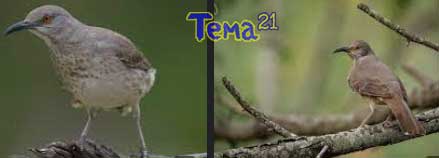
The curve-billed thrasher is predominantly greyish-brown in color, with a lighter underside and darker upper parts. As its name suggests, its most distinctive feature is the curved bill. This heavy, down-curved bill is an essential tool for foraging in the harsh desert environment, allowing the bird to dig, flip leaf litter, and turn over small rocks in search of food. In addition, the bird’s legs are long and sturdy, enabling it to navigate the rocky terrain easily. Finally, its eyes are bright orange, adding color to its otherwise subdued appearance.
Although there are no significant differences between males and females in appearance, males tend to be slightly larger and may have a more pronounced curve in their bills. The curve-billed thrasher’s size typically ranges from 10 to 12 inches, with a wingspan of 13 to 14 inches.
To thrive in the desert, the curve-billed thrasher has developed several adaptations. For instance, it has a nasal salt gland that helps it excrete excess salt, allowing it to maintain a proper electrolyte balance despite its environment’s scarcity of fresh water. Furthermore, its diet consists of a mix of insects, fruits, and seeds, which provide the bird with the nutrients and moisture it needs to survive in the arid landscape.
The table below compares the curve-billed thrasher to similar species, such as Bendire’s thrasher and the desert thrush, highlighting key differences and similarities:
| Species | Characteristics | Habitat & Diet |
|---|---|---|
| Curve-billed Thrasher | Size: 10-12 inches Coloration: Greyish-brown, lighter underside Bill Shape: Heavy, curved |
Habitat: Deserts, arid brush, suburban habitats Diet: Insects, fruits, seeds |
| Bendire’s Thrasher | Size: 9-11 inches Coloration: Brownish-grey, buffy-white underside Bill Shape: Slightly curved |
Habitat: Desert scrub, grasslands Diet: Insects, fruits, seeds |
| Desert Thrush (species) | Size: 7-9 inches Coloration: Brownish-grey, pale grey underside Bill Shape: Straight, thin |
Habitat: Desert scrub, arid grasslands Diet: Insects, fruits, seeds, earthworms |
By understanding the physical characteristics and adaptations of the curve-billed thrasher, we can better appreciate the unique features that enable it to survive and thrive in the challenging desert environment.
Distribution and Habitat
The curve-billed thrasher has a fascinating distribution pattern and occupies diverse habitats. This section will discuss the regions where the curve-billed thrasher can be found, its preferred habitats, such as deserts and dry brush, and its increasing presence in suburban neighborhoods and cities. We will also examine sightings in Arizona and other southwestern states, where this bird is widespread.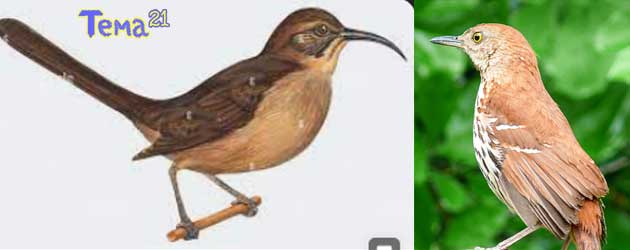
The curve-billed thrasher is native to the southwestern United States, Mexico, and Central America. In the US, it can be found in Arizona, New Mexico, Texas, and parts of Colorado, Kansas, and Oklahoma. Its distribution in Mexico spans from the northern regions to the central plateau and extends into the northernmost areas of Guatemala and Honduras in Central America.
The bird’s preferred habitats include deserts, arid brushlands, and grasslands, where it can find suitable nesting sites and abundant food sources. It is particularly fond of mesquite, acacia, and other thorny vegetation, which protect it from predators and provide a place to build its nest. The curve-billed thrasher is well-adapted to these harsh environments, and its physical characteristics and behaviors enable it to thrive in such settings.
In recent years, the curve-billed thrasher has also made its way into suburban neighborhoods and cities, where it takes advantage of the abundant food resources provided by ornamental plants and bird feeders. This adaptability has allowed the bird to expand its range and flourish in areas where it may not have been found previously.
Arizona and other southwestern states are hotspots for curve-billed thrasher sightings. In Arizona, for example, the bird is a year-round resident and can be found in various habitats, including desert scrub, foothills, and urban environments. However, the species is particularly abundant in the Sonoran Desert, where its particular song and striking orange eyes make it a favorite among bird enthusiasts.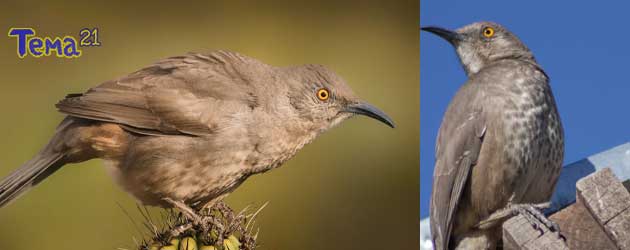
The curve-billed thrasher is a versatile bird with a wide distribution across the southwestern United States, Mexico, and Central America. Its preference for desert and arid habitats, as well as its ability to adapt to suburban and urban environments, has enabled it to thrive in a diverse array of settings. Sightings are prevalent in Arizona and other southwestern states, where the bird’s unique characteristics and captivating song make it a beloved species among birdwatchers and nature enthusiasts alike.
The Curve-Billed Thrasher’s Song
One of the most fascinating aspects of the curve-billed thrasher is its song and vocalizations. In this section, we will describe the bird’s song, compare its vocalizations to those of other thrasher species, and provide audio samples or links to popular recordings that will enable you to appreciate its unique vocal abilities.
The curve-billed thrasher’s song is a complex and melodic series of notes characterized by its varied pitch, length, and rhythm. It often starts with low, guttural notes, followed by musical and harsh, scratchy sounds. The song can last several minutes, with the bird often repeating specific phrases and incorporating mimicry of other birds’ songs. These vocalizations are essential for establishing territory and attracting mates during breeding.
The curve-billed thrasher’s song is more varied and intricate than other thrasher species. For instance, the Bendire’s thrasher, a closely related species, has a generally less complex and monotonous song. The brown thrasher, another member of the thrasher family, is known for its exceptional vocal mimicry but has a song with less variation in pitch and rhythm than the curve-billed thrasher.
To fully appreciate the curve-billed thrasher’s song, it is best to experience it through audio samples or recordings. Here are a few popular resources that capture the bird’s vocalizations: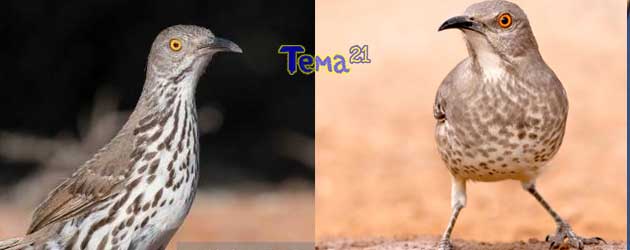
- The Cornell Lab of Ornithology’s Macaulay Library: This extensive collection of bird recordings includes numerous examples of curve-billed thrasher songs and calls. Search for „curve-billed thrasher“ to access the available recordings.
- Xeno-canto: This community-driven website offers a wide variety of bird recordings worldwide. Search for „curve-billed thrasher“ to find a selection of high-quality audio samples.
- National Audubon Society’s Guide to North American Birds: The National Audubon Society provides a brief profile of the curve-billed thrasher, including an audio clip of the bird’s song for easy reference.
The curve-billed thrasher’s song is a remarkable and intricate series of vocalizations that sets it apart from other thrasher species. By exploring the available audio samples and recordings, you can gain a deeper appreciation for the bird’s unique vocal talents and enjoy the captivating sounds of this fascinating species.
Behavior and Ecology
This section will explore the behavior and ecology of the curve-billed thrasher, delving into the bird’s feeding habits, nesting behavior, breeding season, interactions with other species, and its role as a pollinators and seed dispersers.
Feeding habits and diet
The curve-billed thrasher is an omnivorous bird, consuming a diverse diet that includes insects, arachnids, fruits, and seeds. Its primary food sources are insects such as beetles, ants, grasshoppers, and spiders. The bird forages on the ground, using its curved bill to probe the soil and leaf litter in search of prey. During the non-breeding season, the curve-billed thrasher’s diet shifts towards fruits and seeds, particularly those from cacti, mesquite trees, and other desert plants.
Nesting behavior and breeding season
The curve-billed thrasher’s breeding season typically spans from February to August, with a peak in nesting activity between April and June. The bird builds a bulky, cup-shaped nest using twigs, grasses, and plant fibers, often lining the interior with softer materials such as feathers and fur. Nests are usually constructed in dense shrubs, cacti, or low trees, protecting from predators and shade from the desert sun.
The female curve-billed thrasher lays a clutch of 2 to 4 pale blue eggs, which are incubated for approximately 12 to 14 days before hatching. Both parents feed and care for the nestlings, which remain in the nest for an additional 17 to 19 days before fledging.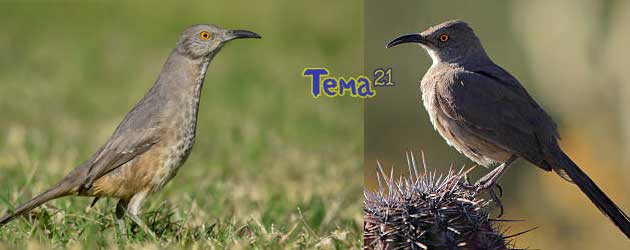
Interaction with other species, such as the cactus wren
The curve-billed thrasher shares its habitat with various bird species, including the cactus wren. Although these two species may occupy similar niches, they generally coexist peacefully, with minimal resource competition. The curve-billed thrasher’s larger size and more aggressive demeanor can sometimes deter smaller birds, like the cactus wren, from nesting too close to their territory. However, these species often benefit from each other’s presence, as they help to alert one another to potential threats or predators in their shared environment.
Role as pollinators and seed dispersers
The curve-billed thrasher is vital in its ecosystem as a pollinator and seed disperser. Its diet of fruits and seeds from desert plants, such as cacti and mesquite trees, allows the bird to transfer pollen from one plant to another, facilitating cross-pollination and producing viable seeds. Furthermore, as the bird consumes these fruits and grains, it disperses them throughout its range, often depositing them in new areas through its droppings. This seed dispersal process helps maintain the health and diversity of desert plant communities, ensuring the continued survival of both the plants and the animals that depend on them.
Identifying Similar Species
A variety of bird species may bear a resemblance to the curve-billed thrasher, particularly within the thrasher and thrush families. In this section, we will compare the curve-billed thrasher to these similar species and provide a table highlighting key differences in appearance and behavior. Additionally, we will offer tips for distinguishing between the curve-billed thrasher and its look-alike counterparts.
Comparison to other species, like thrushes and thrashers
The curve-billed thrasher is a member of the Mimidae family, which includes other thrashers, mockingbirds, and catbirds. Within this family, species like the Bendire’s and sage thrasher may resemble the curve-billed thrasher in size and shape. However, these species often exhibit subtle differences in plumage, bill shape, and vocalizations.
Thrushes, belonging to the Turdidae family, are another group of birds that can be mistaken for the curve-billed thrasher. For instance, American robins and hermit thrushes may share a similar body size and shape. Nevertheless, thrushes generally have a more uniform plumage and a less distinct bill curve than the curve-billed thrasher.
A table highlighting key differences in appearance and behavior
| Species | Appearance | Behavior |
|---|---|---|
| Curve-billed Thrasher | Grayish-brown spotted breast, curved bill | Ground foraging, desert habitat |
| Bendire’s Thrasher | Pale gray, faint spotting, straighter bill | Ground foraging, shrublands, and grasslands |
| Sage Thrasher | Grayish-brown, white streaks, straight bill | Ground foraging, sagebrush habitat |
| American Robin | Gray-brown, red breast, straight bill | Ground foraging, urban and woodland habitat |
| Hermit Thrush | Brownish, reddish tail, straight bill | Ground foraging, forest, and woodland habitat |
Tips for distinguishing between the curve-billed thrasher and similar species
To differentiate the curve-billed thrasher from other similar species, consider the following tips: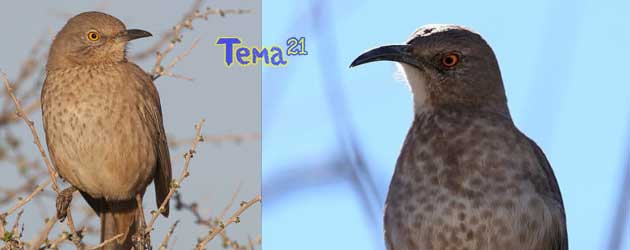
- Observe the bill shape: The curve-billed thrasher’s distinct curved bill sets it apart from thrushes and other thrashers with straighter bills.
- Examine the plumage: The curve-billed thrasher has a grayish-brown color with a spotted breast, contrasting with the more uniform coloration of thrushes or the faint spotting of the Bendire’s thrasher.
- Listen to vocalizations: The curve-billed thrasher’s song is distinct from other thrashers and thrushes, characterized by varied and melodic phrases.
- Consider the habitat: Curve-billed thrashers are primarily found in the desert and arid brush habitats, while thrushes and other thrashers may occupy different environments, such as forests, grasslands, or sagebrush habitats.
By paying attention to these distinguishing features, bird enthusiasts can more accurately identify the curve-billed thrasher and differentiate it from other similar species.
Conservation Status and Threats
As an essential species in its ecosystem, the curve-billed thrasher warrants attention regarding conservation efforts. This section will discuss the current conservation status of the curve-billed thrasher, its threats, and the measures being taken to protect and conserve the species.
Current conservation status of the curve-billed thrasher
The curve-billed thrasher is currently listed as a species of „Least Concern“ by the International Union for Conservation of Nature (IUCN) Red List. This classification indicates that the species is not facing any immediate threats of extinction. The curve-billed thrasher’s wide distribution across the southwestern United States and northern Mexico and its adaptability to various habitats contribute to its stable population numbers.
Threats to the species, including predators and habitat loss
Although the curve-billed thrasher is not under immediate threat, it still faces challenges within its environment. Predators, such as snakes, larger birds, and mammals, can risk the curve-billed thrasher, particularly during the nesting season when eggs and fledglings are vulnerable.
Habitat loss is another potential threat to the curve-billed thrasher population. Urbanization and agricultural expansion can destroy the bird’s native desert and arid brush habitats. Additionally, climate change may impact the availability and distribution of food resources, potentially affecting the curve-billed thrasher’s survival in certain regions.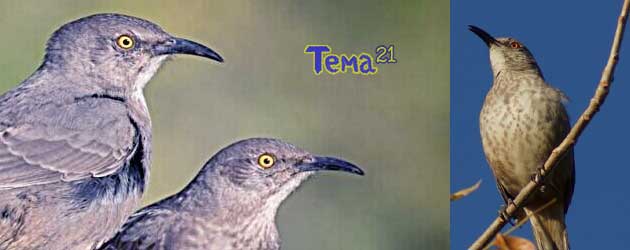
Efforts to protect and conserve the species
Given the curve-billed thrasher’s current conservation status, large-scale efforts to protect the species still need to be implemented. However, preserving the bird’s natural habitats and maintaining healthy ecosystems are essential for the long-term survival of the curve-billed thrasher and many other species that share its environment.
Land management practices that protect and restore native vegetation in the desert and arid regions can help ensure the continued presence of suitable habitats for the curve-billed thrasher. Educating the public about the importance of these unique ecosystems can also contribute to conservation efforts, fostering a deeper appreciation for the birds and other wildlife that call these environments home.
While the curve-billed thrasher is not currently at risk, monitoring population trends and habitat changes is crucial to ensure the species’ continued success and conservation.
Attracting and Supporting Curve-billed Thrashers
Creating a bird-friendly habitat in your backyard can be a rewarding experience for nature enthusiasts, and the curve-billed thrasher is no exception. This section will provide tips for designing an inviting space for these fascinating birds, discuss native plants and vegetation that provide food and shelter, and recommend popular bird feeders and products to support curve-billed thrashers. Additionally, we will offer advice on responsible birdwatching and photography practices.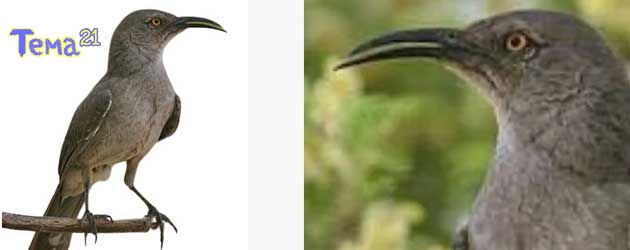
Tips for creating bird-friendly habitats in your backyard
- Native vegetation: Planting native vegetation in your backyard is an excellent way to attract curve-billed thrashers and other local bird species. Native plants provide food, shelter, and nesting materials, ensuring the birds feel safe and comfortable in their environment.
- Water sources: Birds, including curve-billed thrashers, need fresh water for drinking and bathing. Installing a birdbath or small pond can entice these birds to visit your yard regularly.
- Nesting sites: Providing suitable nesting sites like dense bushes or cacti can encourage curve-billed thrashers to settle in your backyard. Avoid trimming vegetation during the breeding season, as this may disturb nesting birds.
Native plants and vegetation that provide food and shelter
Several native plants can serve as food sources and protection for curve-billed thrashers. Some options include:
- Mesquite trees (Prosopis spp.): These trees provide insects and seeds as food sources and shelter and nesting sites.
- Cholla cacti (Cylindropuntia spp.): These cacti offer protection and nesting opportunities for curve-billed thrashers.
- Prickly pear cacti (Opuntia spp.): Besides providing shelter, prickly pear cacti produce fruits that are a food source for many bird species, including curve-billed thrashers.
Popular bird feeders and products that support curve-billed thrashers
While curve-billed thrashers primarily feed on insects and seeds, you can supplement their diet with bird feeders filled with various seeds or suet. Platform feeders or ground feeders are preferable, as these feeders are more accessible for thrashers.
Advice for responsible birdwatching and photography
Observing and photographing curve-billed thrashers can be an enjoyable pastime, but it’s essential to do so responsibly. Here are some tips for ethical birdwatching and photography:
- Maintain a respectful distance: Avoid getting too close to the birds, which can cause stress and disturb their natural behavior.
- Avoid using flash photography: Flash can startle birds and disrupt their activities. Utilize natural light whenever possible for your photographs.
- Do not disturb nests: Keep a safe distance from nesting sites to prevent inadvertently frightening the birds or causing them to abandon their nests.
By following these guidelines and creating a welcoming habitat in your backyard, you can enjoy the presence of curve-billed thrashers and support their conservation.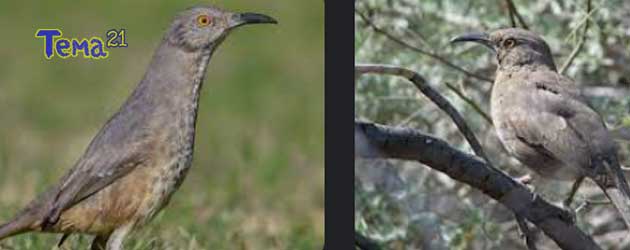
References
Here are some recommended books available on Amazon that cover various aspects of the curve-billed thrasher and related topics:
- A Field Guide to the Birds of North America by National Geographic Society
- Cacti, Agaves, and Yuccas of California and Nevada by Stephen Ingram
- Birds of the American Southwest by Lynn Hassler Kaufman
- Attracting Birds to Your Backyard: 536 Ways to Turn Your Yard and Garden into a Haven for Your Favorite Birds by Sally Roth

Марта Савова е журналист и писател, специализиран в областите здравеопазване, технологии и наука. С над 20-годишен опит в сферата, тя е публикувала множество изследователски статии и има страст към споделянето на знания. Марта е редовен сътрудник на различни медии.
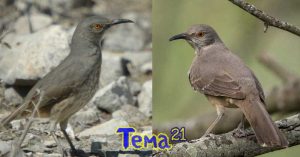
The article provides some excellent tips for creating bird-friendly habitats, but I’d like to emphasize the importance of using native plants that are well-adapted to local conditions. It benefits the birds, conserves water, and supports the ecosystem’s overall health.
In my experience, curve-billed thrashers can sometimes be quite aggressive towards other bird species at bird feeders. It might be helpful for readers to know this, so they can take appropriate measures if they wish to attract a more diverse array of bird species to their backyard.
The article mentions that curve-billed thrashers are primarily found in the southwestern United States and Mexico. However, their range extends into central Mexico and parts of the Great Basin. It’s essential to recognize the full extent of their distribution.
While the article covers the interaction between curve-billed thrashers and cactus wrens, I’d like to add that their competition for nesting sites can sometimes lead to the displacement of other bird species, such as the Gila woodpecker, which also relies on cavities in saguaro cacti.
Interesting article, but I’ve noticed that curve-billed thrashers in my area prefer foraging in leaf litter rather than on the ground. It may vary by location, but it’s worth noting that their foraging behavior may not be the same everywhere.